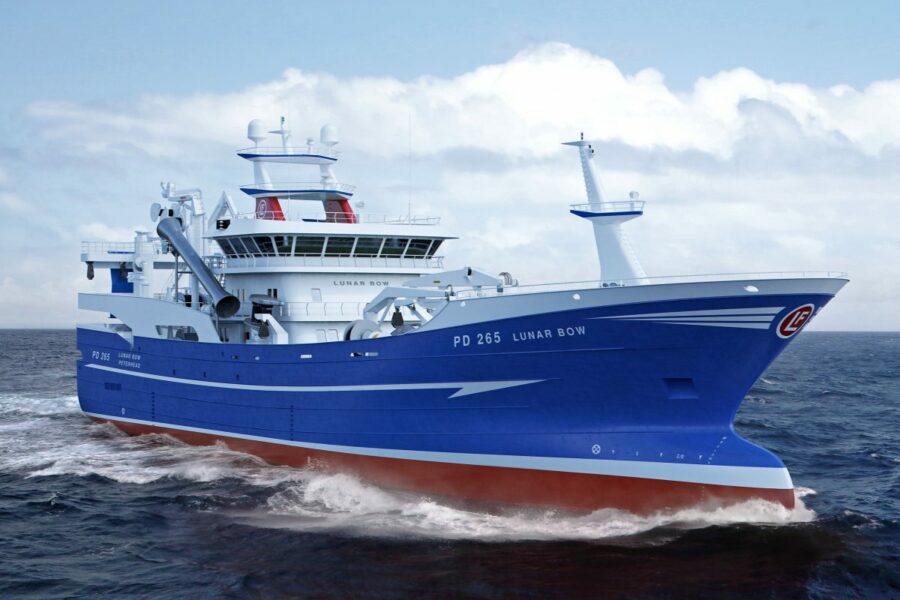Extensive new-build programme brings a wide range of benefits
More than 50 new boats, ranging in size from 7m to 80m, are scheduled to be delivered to UK skippers in the next three years, representing an unprecedented reinvestment in the fishing industry of around £300m, reports David Linkie
The last quarter of this year will see the delivery of some 10 new boats, including whitefish, pelagic and shellfish vessels. A similar level of new fleet additions is scheduled for 2019 and 2020.
Of particular significance is the fact that the new builds encompass a wide range of vessel types, target species and geographical areas.
Fly-shooters, pair-seiners, scallopers, single-, twin-rig and beam trawlers, vivier crabbers and pelagic vessels are at various stages of design and build for owners in Shetland, Orkney and the Western Isles, Devon and Cornwall, as well as North East Scotland. Inshore static-gear boats are also well represented.
The level of interest that skippers continue to show in purpose-built new boats is such that UK boatyards have healthy order books stretching several years ahead.
When some 40 new boats handed over to owners in the past two years are taken into account, this represents extremely strong levels of commitment and confidence in the long-term future of the UK fishing industry.
The level of current investment in any industry has always been recognised as a strong indicator of its long-term future. Therefore, the fact that over £400m is being invested over a five-year period to build state-of-the-art new vessels that will enable skippers and their crews to catch their annual quotas with enhanced safety, efficiency and financial viability, is a very positive and welcome sign.

Lunar Bow is one of 50-plus new boats scheduled to be completed for UK skippers in the next few years.
New boats incorporating new ideas and the latest technological developments, allied with minimal maintenance costs, have long been recognised as representing the most cost-effective way of fishing. However, the lack of clarity and certainty that generally prevailed in the industry, at a time when quotas and fishing opportunities were on a steady downward spiral, meant that strongly motivated younger skippers were unable to firmly grasp the initiative by taking the then quantum leap to a new boat.
Some of the new boats now joining the UK fleet are replacing boats that have more than 30 years of service under their keels. Others will replace boats built in the past 10 years, as skippers who have experienced at first-hand the financial benefits of new boats, go again in order to retain momentum.
At a time when the UK fleet has an average age of 35 years, the importance of recent and future new builds cannot be overstated.
UK skippers, together with designers and boatyards, have long been associated with progressive thinking and innovation. Such forward thinking continues to be seen, with new ideas constantly being implemented to further enhance safe working practices, fuel efficiency and catch quality.
That such developments are being delivered is largely attributable to the healthy and sustainable stocks now present in UK waters, as a result of the pioneering measures fishermen implemented some 15 years ago. The benefits – which accrued much more quickly than most anticipated – were instrumental in persuading bank managers to view requests for funding for new boats in a totally different light, and give favourable responses.
Wide-ranging benefits
The current level of investment in new boats is also bringing a cascade of related benefits.
The imminent arrival of new vessels is stimulating activity in second-hand boat sales. Given that these are also well-recognised as being a barometer of a viable industry, this represents further positive news. In recent years, the level of boat sales in the UK fleet has probably been at an all-time low, largely due to the shortage of orders for new builds, which in turn meant an acute shortage of modern second-hand vessels.
Now, relatively modern boats scheduled to be replaced by new tonnage, are quickly being snapped up by younger skippers looking to advance their careers.
With strong order books for several years ahead of them, boatyards are also benefiting from the continuity and stability this brings.

The 24m twin-rig trawler Uberous is nearing an advanced stage of completion at Whitby for Fraserburgh skipper Ian Duthie.
Three of the leading boatyards in the UK, Macduff Shipyards, Parkol Marine Engineering and C Toms & Son, have recently expanded their boatbuilding and slipping facilities. Further developments, including increasing their workforce and taking on apprentices, are also ongoing.
New builds are equally important to the wide range of service companies that are involved in the manufacture and supply of new machinery and equipment to each new vessel. Engine and deck machinery suppliers, electronic and refrigeration companies, as well as netmakers, are all reporting increased business.
The bespoke levels of catch quality and full traceability associated with new boats will continue to generate confidence with retail companies and consumers, at a time when their requirements and expectations of seafood are at an all-time high.
Skippers and processors alike have worked extremely diligently for some time now to increase demand for all types of seafood and develop new markets. In a highly competitive international market, the current level of investment in new boats sends out an extremely positive message that will generate further confidence in the all-important end user, without whom, new vessels would not be being built.








